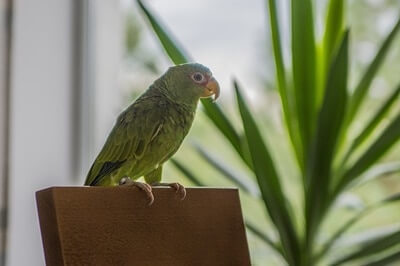Last Updated on January 28, 2024 by Carrie Stephens
People living in apartments know all too well how much noise travels between the different units. Choosing a relatively quiet, well-behaved parrot is essential for keeping the neighbors happy.
There’s no such thing as a silent pet bird. Parrot species like budgies, parrotlets, Pionus parrots, cockatiels, Meyer’s parrots, lovebirds, and Bourke’s parakeets are best suited to apartment living.
Considerations Before Getting An Apartment Parrot
- Noise level: Vocalizations can be frequent. What maximum decibel level can the parrot produce?
- Cage size: A parrot needs a good-sized cage. Are you already short of space?
- Freedom: Is there room for the parrot to fly freely when released from its cage?
- Temperament: Some species are more relaxed than others. Will the parrot be scared by noises from neighbors or passing road traffic? Will night frights be an issue?
- Messiness: Parrots drop food everywhere, splash water, produce feather dust, and poop frequently. Is the apartment easy to clean or cluttered? Feather dust can cause Bird Fancier’s Lung (BFL).
- Second parrots: Some parrots dislike being alone. Will you need two parrots? Although parrots keep each other company, a pair will be noisier and require a bigger cage or two cages.
- Predatory pets: If you have other pets, like cats and dogs, will this cause problems?
- Personal availability: Parrots are unsuitable if you work long hours. Boredom and neglect often manifest in undesirable behaviors like feather-picking and noisiness.
Landlords And No-Pets Policies
Some landlords allow pet parrots, while others have a no-pets policy. If the rental agreement has a no-pets policy, you won’t be able to keep a parrot, even if it’s a small and quiet species.
An apartment is a shared living space, so the rules can be strict to protect other residents. Also, landlords don’t want their investment property to be damaged.
Check the apartment’s terms and conditions to determine whether pet parrots are allowed.
Unsuitable Parrots for Apartment Living
- Alexandrine parakeets.
- Eclectus parrots.
- Amazon parrots.
- African gray parrots.
- Macaws (including mini macaws).
- Cockatoos.
- Ringneck parakeets.
Parrots Good for Apartments
If an apartment’s rules permit the keeping of pets, look for a small and relatively quiet parrot.
Here are the best parrots for apartments:
Budgerigars

Budgies are among the world’s most popular parrots because they’re small, affectionate, communicative, and trainable.
They’re small-sized parrots, averaging just 7 to 9 inches from head to tail. Pet budgies can live for 7-15 years.
According to The Journal of the Acoustical Society of America, budgies have a complex and varied vocal repertoire.
Budgies are less noisy than most birds (up to 70 decibels) but chatter and chirp a lot. They’re surprisingly good talkers and can develop an extensive vocabulary of words with training.
Budgerigars have playful and excitable personalities that enjoy interacting with their owners. After basic training, you can teach a budgie to step on your finger and perform fun tricks.
Bonded budgerigars can live in pairs in the same cage. However, they may fight over food and territory, which can get boisterous. Some fights can turn nasty, harming the relationship.
Consider getting an English budgie if you want an alternative to an American parakeet. They’re not as long-lived but tend to be more relaxed and less territorial.
The minimum cage size for a single budgie is 18.5 x 18.5 x 18.5 inches. If you plan to keep a pair of budgies, get a 36 (long) x 24 (height) x 24 (width) inch cage with ½ inch bar spacing.
Parrotlets

Parrotlets are 4.5 to 5 inches with larger-than-life personalities. They’re clever, social, active, playful, and curious-natured.
Despite their diminutive size, Pacific parrotlets can be feisty with strong-willed and determined personalities.
Parrotlets bond with their owners, craving attention and social interaction. A second bird is recommended to keep them company while you’re at work or college.
Parrotlets live for an average of 15-20 years in captivity.
They aren’t noisy birds (because they’re tiny), especially if you keep them entertained. However, they can become more vocal if they feel ignored or aren’t getting their way.
While parrotlets aren’t the best talkers, they can learn a few words if given training.
Although parrotlets like to interact and play, they can amuse themselves if you provide 3+ perches, shredding toys, swings, ladders, puzzles, and bells.
According to the Animal Humane Society, parrotlets require an 18 x 18 cage with 5/8″ inch bar spacing.
Pionus Parrots

Pionus parrots are medium-sized parrots (about 10-12 inches) with a gentle nature and laid-back personality.
The average Pionus has a life expectancy of 25-40 years.
Although there are 8 species of Pionus parrots, just 5 (blue-headed, Maximilian’s, white-capped, dusky, and bronze-winged) are commonly kept as household pets.
Pionus parrots aren’t as noisy as other birds but grow louder if you have an active home.
Pionus parrots can talk, but their voice isn’t as clear as that of some species. However, Pionus parrots can develop an impressive vocabulary.
They’re sensitive to changes in their environment and routine, so they need consistency to thrive.
Pionus parrots are affectionate birds that enjoy one-on-one time with their owners. They’re clever birds that thrive on learning, engaging, and interactive play.
The cage size for a Pionus parrot is 24 (width) x 24 (length) x 30 (high) inches with ½ inch bar spacing.
Cockatiels

Cockatiels are popular due to their loveable personalities, expressive crests, and adorable orange cheeks.
Cockatiels are among the best beginner species because they’re medium-sized (about 12-13 inches) and live for 15-20 years.
The position of their crest feathers reveals how they’re feeling.
Raising the crest implies curiosity, while a flattened crest is more defensive. However, if the crest feathers aren’t fully raised, this suggests it’s more relaxed and at ease.
Cockatiels can learn to talk but are likelier to make bird vocalizations. These include:
- Whistling.
- Chirping.
- Warbling.
- Squawking.
Cockatiels may hiss and scream when defensive or afraid. Usually, they’re less noisy than other species (including other cockatoos), so they can make ideal apartment pets.
Cockatiels are prone to night frights, where they see or hear something that scares them and causes them to panic. Placing a cover over the cage at night may help them sleep better.
Cockatiels need at least a 24 (long) x 18 (wide) x 24 (high) inch cage with 5/8″ inch bar spacing.
Meyer’s Parrots
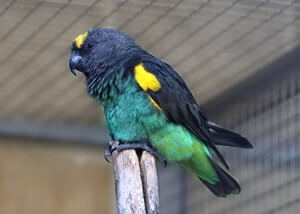
Meyer’s parrots are easy-going and gentle birds, making them ideal family and apartment pets.
Meyer’s parrots belong to the Poicephalus family (the same classification as Senegal parrots).
They’re small parrots that average 8-9 inches long and can live for 25-30 years with the proper care and attention.
Meyer’s parrot sounds consist of chirps, whistling, clicking, and high-pitched squeaks. They can learn some words if they hear and repeat them often enough, but they aren’t good talkers.
Don’t be alarmed if the parrot makes a beep or alarm sound from where it’s copied an electrical device.
They need a 20 x 20 x 18-inch cage with 5/8-inch bar spacing.
Bourke’s Parakeets
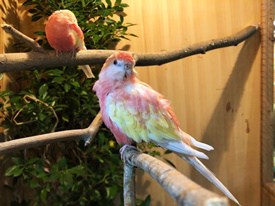
Bourke’s parakeets (pink parakeets) are small birds that reach an average of 7-8 inches in length.
They’re well-known for their quiet, relaxed nature, making less noise than most other parrot species. However, they’re energetic birds.
Bourke’s parakeets enjoy the company of their owners during their lifespan, which averages 15-25 years.
Bourke’s parakeets produce pleasant sounds, but they don’t talk. When startled, they produce a sharp, high-pitched sound, so they suit living in a relatively quiet apartment.
Bourke’s parakeets need a 24 x 30 x 24-inch cage with ½ inch bar spacing.
Lovebirds
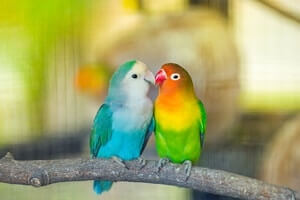
The genus Agapornis comprises 9 different lovebirds, the most popular being the peach-faced, masked, and Fischer’s lovebirds.
Lovebirds are popular due to their gentle personality and compact size (about 5-6.5 inches). Lovebirds live for 10-15 years.
Lovebirds don’t need another lovebird to be happy, provided you offer friendship and companionship. Two birds are recommended if you have a full-time job.
If you get a pair of lovebirds, you may find it’s less attentive toward you.
Lovebirds show affection by whistling and chattering rather than talking. They also squeak and sing as they explore the home but rarely become too noisy for neighbors to hear.
Lovebirds need a 24 x 18 x 24-inch cage with ½ inch bar spacing.
Senegal Parrots

Despite their intense gaze, Senegal parrots are playful birds that enjoy frolicking with their owners.
Senegal parrots average about 9 inches long, with an average life expectancy of 25 to 35 years.
They need 2-3 hours of out-of-cage time to play and explore, or they’ll become prone to stress and behavioral problems.
Senegals are good talkers. They also mimic sounds, including:
- Coughs.
- Clicker sounds.
- Alarm clocks.
- Sirens.
- Sneezes.
They’re ideal for an apartment setting because they don’t make ear-splitting screams.
The cage size for a Senegal parrot is 24 x 24 x 32 inches with 5/8″ inch bar spacing.
Red-bellied Parrots
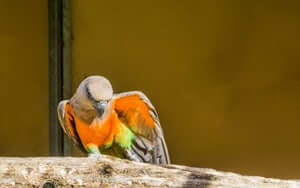
Red-bellied parrots are small (about 9 inches long) with an average life expectancy of 20-25 years.
When socialized early in life, red-bellied parrots are active and social birds that enjoy engaging with humans. This is a fun part of their personality if you have people visiting the apartment.
They’re not particularly vocal birds, especially compared to other members of the Poicephalus genus. This means they rarely screech and squawk.
They can talk a little and mimic sounds, making them entertaining parrots.
The right cage size for a red-bellied parrot is about 28 x 20 x 24 with 5/8″ inch bar spacing.
Barred Parakeets

Also known as the lineolated parakeet, barred parakeets are sometimes mistaken for budgies, although they’re slightly smaller and stockier.
The average barred parakeet grows to be 6 to 6.5 inches long and has a life expectancy of 10 to 15 years.
Lineolated parakeets are friendly and even-tempered birds that enjoy the company of their owners. They’re considered comical and entertaining.
Their natural call is soft and gentle, almost like a song. They chatter rather than screech because they spend most of their time attempting to mimic sounds and phrases. However, they’re better at mimicking sounds than talking.
The ideal cage size for a barred parakeet is 18 x 24 x 18 inches with ½ inch bar spacing.
All birds are vocal and communicative, but the maximum volume produced by smaller parrots is much lower. While an apartment has limited space, get the largest square or rectangular cage possible.

